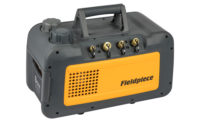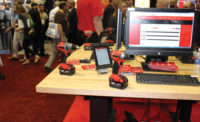Zoning Gets Smarter, More Accessible at 2016 AHR Expo
Bypass damper legislation and ease of access are hot-button topics

ZONE DAMPER: Aprilaire’s zone damper powers closed, allowing conditioned air to continue to flow if the mechanical motor reaches the end of its service life.

FUNCTION FIRST: Dick Foster, president of Zonefirst, showcases the functionality of the company’s new bypass eliminator.

ECO-FRIENDLY: The Ecovent zoning system’s actual vents are powered by 4 AA batteries. The product’s app will send a notification when the batteries are running low.



ORLANDO, Fla. — Zoning remains a relatively small slice of the overall HVAC pie, but it’s growing, both in relevance and installations. At the 2016 AHR Expo in Orlando, Florida, zoning manufacturers showcased next-generation equipment that harnessed the Internet of Things and interconnectivity, granting homeowners full control over each area of their homes.
Dick Foster, president of ZoneFirst, said the biggest obstacle in zoning continues to be the fact that it is not as accepted as it should be throughout the marketplace, but the numbers are improving, and “contractors are starting to see the benefits of selling a fully zoned system over something like a mini split.”
BRIDGING THE BYPASS
ZoneFirst showcased a bypass eliminator that allows a user to set a pressure sensor within the ductwork and decide on an upper and lower limit of pressure.
“A contractor needs to be able to set the limits,” said Foster. “Every system is a little bit different. Most contractors don’t know how to balance a system, and they don’t know how to commission a system. They put it in, and, if air flows, that means it works and they are happy. I think every system needs to be commissioned and tweaked a little bit. With zoning, you have different zones and you want to make sure the zones are working. You are able to blow air that is not objectionable or noisy and also be able to test it based on the equipment, so you are not harming the equipment.”
Mike Rimrodt, marketing director for Aprilaire, pointed out that zoning and ventilation are both driven quite a bit by new home construction, and contractors want products that are extremely easy to install and service.
“In the past, you may have a downstairs and an upstairs system to control the temperature in both places,” said Rimrodt. “Now, builders are realizing it’s a lot less expensive to put a zoning system in and just use one system, a series of dampers, and a couple of thermostats. It’s efficient for homeowners, too, because they’re only directing the conditioned air where it needs to be for comfort in the house, as opposed to having an upstairs system on full blast and a downstairs system totally shut off or vice versa.“
Aprilaire’s redesigned damper line was on display at the Expo. The products feature a new actuator designed to be serviceable while the damper is still in the ductwork. They are also designed so that if a contractor ever needs to make a changeout, they remove one screw and the actuator, put the new actuator on, and wire the unit back up. The company also showcased a new line of zone panels at the show.
Similarly, Honeywell Intl. Inc. announced the availability of the TrueZONE® Damper, which provides a visual position indicator as well as open and close lights to quickly allow contractors to know the position of the blade in the ductwork. The product was designed as a direct replacement to Honeywell’s legacy zone dampers.
“Zoning has always been a comfortable and energy-efficient solution, but installing and maintaining a traditional zoning system comes with risks,” said Kevin Graebel, director of residential health and awareness, Honeywell. “Contractors understand it is costly to revisit a home if the installation was done incorrectly. The Honeywell TrueZONE system helps reduce the complexity of a zoning installation at a competitive price.”
Graebel also noted that the growth in connected products in the home continues to be a major driver for zoning, as well.
“It’s a wonderful experience for a person to be able to utilize the Total Connect Comfort app and be able to control the temperature in multiple areas of his or her house independently,” he said. “It’s a huge evolution in comfort and energy savings, even compared to zoning systems that require you to set each thermostat manually.”
DAMPER LEGISLATION
As zoning products, specifically new bypass dampers and accessories, are introduced to the marketplace, manufacturers are also readily aware of Title 24 legislation in California.
The TrueZONE damper from Honeywell has adjustable range stops that allow for consistent air bleeding settings, in part because it “makes it a snap to meet Title 24 requirements,” according to Graebel.
In regards to that legislation, a new study was recently conducted by the Air-Conditioning, Heating, and Refrigeration Institute (AHRI) that evaluated the impact on the EER of a bypass-type single-stage cooling zone system. The results revealed a positive influence on the system’s EER, with no negative impact.
Foster said the results of this study will prove beneficial for both manufacturers and contractors.
Dip Patel, CEO, Ecovent Corp., said he expects legislation banning bypass ducts to expand across the country, and that Ecovent is uniquely positioned to give contractors an option to install a zoning solution that doesn’t require bypass ducts.
CONNECTING IT ALL
Outside of the legislation, zoning products on the show floor highlighted the push towards intelligence and connectivity.
Arzel Zoning Technology Inc. displayed the Haven, a wireless, app-driven, energy-harvesting zoning system. Per Arzel, the system has five main parts: the temperature controller (TC), damper, equipment control box (ECB), and two apps. The TC is what takes the place of the thermostat. It can be wall-mounted or sit on a desk, counter, or anywhere else. Each damper has its own pump rather than one main pump in the panel. It also has its own energy-harvesting impeller that functions when the zone is calling and the damper opens.
The Ecovent room-by-room temperature control system uses self-configuring sensors and vents. It plugs into a standard wall outlet in each room, detects the climate of that room, and sends information to what it calls the smart hub. It controls an HVAC system through a compatible thermostat and opens and closes the vents to get all of the rooms to a desired temperature. Each room’s temperature is set using a mobile app.
“We’re seeing greater consumer demand for smart home products that solve a clear-use case, like Ecovent does for home comfort,” said Patel. “By integrating real-time static pressure monitoring at every register and the wall sensor, we can control airflow throughout the home while keeping HVAC equipment safe.”
Zoning has an intriguing year ahead of it as the effects of the bypass system field study are felt and new products make zoning a more connected, feasible option for consumers.
Publication date: 2/22/2016
Want more HVAC industry news and information? Join The NEWS on Facebook, Twitter, and LinkedIn today!










